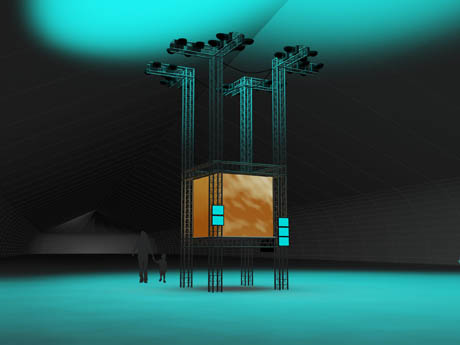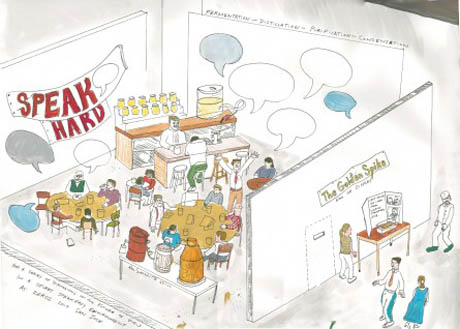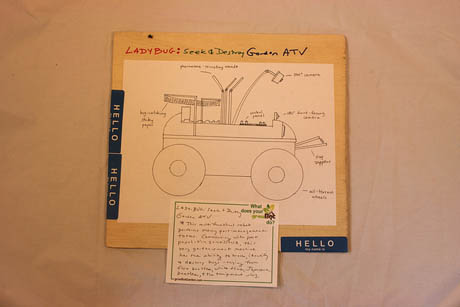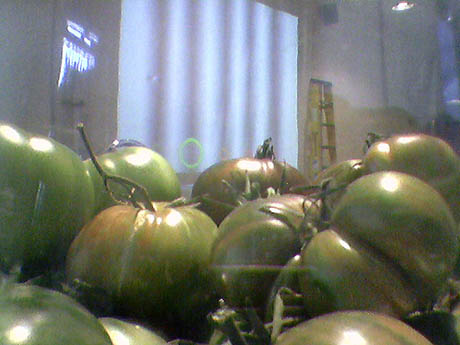Friday, September 17. 2010
Via Edible Geography
-----
By Nicola
If you are in or near San Jose, California, this weekend, these are just some of the delights that await at this year’s 01SJ Biennial.

IMAGE: Transgenic Mosquitoes of California by the Center for PostNatural History.
Under the pioneering and Utopian instruction to “Build Your Own World,” the Biennial’s curators have assembled an enormous quantity of projects that, at a variety of scales, attempt to redesign our environment, infrastructure, atmosphere, and culture.
Unfortunately, some events have already come and gone — I would have loved to have been able to attend Tuesday’s Still Life with Banquet, in which media artist Grahame Weinbren partnered with chef Kitty Greenwald to serve a meal presented in Dutch still-life format, surrounded by video footage of the food’s decay.

IMAGE: Click for video. Still from A1 (Linard), by Grahame Weinbren. Timelapse presentation of a twelve-week shot, based on a still life by seventeenth-century French painter, Jacques Linard.
It’s a clever conceit, but also — I imagine — functioned as a visceral reminder that our obsession with only buying flawless fruit and vegetables over-prioritises a single, freeze-framed moment in an organic cycle.
Ongoing displays include a Seed Garden Library, arranged by micro-climate suitability, from artist Amy Franceschini’s lovely Victory Gardens project, as well as a transgenic mosquito from the collections of the fascinating Center for Post Natural History. The insect, which has been developed in a biosecurity level 3 laboratory at the University of Bamako, in Mali, is designed to resist the malaria parasite, and should be ready for industrial production as early as next year.
According to a report on SciDev.Net, “The researchers hope that resistant mosquitoes will one day take over wild populations, eventually wiping malaria out.”

IMAGE: Amy Franceschini, Victory Garden Seed Library. (Photo by Amy Franceschini).
The San Francisco-based Studio for Urban Projects (SPUR) have created Public Orchard, an installation that includes heritage fruit trees as well as a discussion space to explore creative solutions to overcome city government resistance to urban edible landscapes. SPUR notes that “fruit trees are discouraged in the permit process because of concerns about the mess on city streets,” while fruit picking in parks is often “technically illegal, as it encourages ‘the destruction of park property.’”
In response, their installation investigates low-maintenance models of urban edible landscapes, municipal codes that encourage public foraging, and collaborative opportunities to harvest and preserve food.

IMAGE: i-Weather, by fabric | ch, an installation at the Biennial that creates “an open-source artificial climate” — a parallel 25-hour day based on the most up-to-date knowledge of human metabolism, circadian rhythms, and the medical efficacy of light therapy.

IMAGE: Sunshine Still, an Biennial installation by futurefarmers that uses a converted moonshine still to convert organic waste and algae into “engine-ready ethanol fuel by day and drinkable ethyl alcohol by night.”
Rebar, the creative genius behind today’s PARKing Day, are also represented at the Biennial, with their FarmCycle, “a pedal-powered alternative to the fossil-fuel driven tractor,” better suited to the needs of urban farmers. On a similar note, my generous hosts from earlier this week, Georgia Tech, have collaborated with The Public Design Workshop to create the Growbot Garden, which investigates a scaled-down form of precision agriculture, incorporating robotics and sensing technology into community gardens and green roofs.

IMAGE: Ladybug board, part of the Growbot Garden Flickr set uploaded by Public Design Workshop.
Today’s events include a pop-up edition of the forageSF Underground Market, set up to skirt around legislation that keeps foraged produce out of farmers’ markets by restricting booths to “primary producers,” and not “gatherers,” as well as a not-to-be missed talk by Darrin Nordahl, author of Public Produce, on “municipal agriculture,” or practical strategies to encourage food production on public land (5:30 p.m., registration required).
Meanwhile, tomorrow’s highlights include a biodiesel bus tour of San Jose’s historic urban orchards, as well as an Imaginary Airforce Flight Attendant Training at designer Natalie Jeremijenko’s xAirport facility — your chance to glide along a zipline above the biodiverse riches of a constructed wetland (as opposed to squeezing into a fossil-fuel guzzling 747 on the environmental wasteland that is a runway built on “reclaimed” marsh).

IMAGE: xAirport, courtesy David Fletcher.

IMAGE: SLO DOG, a hot dog roller grill-inspired entry into Saturday’s Green Prix.
The Biennial closes on Sunday, September 19, accompanied by a Tomato Quintet (a “full set of tomato ripening data in a musification which is accelerated by a factor of 240X”) and accompanying fresh salsa. I wish I could be there — let me know what you think, if you go.

IMAGE: Tomato Quintet, in the recording studio. Photo by Greg Niemeyer.
Sunday, September 05. 2010
Via Swissnex San Francisco
-----
San Jose digital art festival showcases “Build Your Own World” projects including a magic book, an Internet light source for space colonies, and the sounds of ripening tomatoes.
4 Sep 2010 - 19 Sep 2010
-
Practical Information:
Location:
Multiple locations in San Jose, CA
-
Cost:
Day pass $24 - Multi-day Pass $45. More information below.
-
The 2010 01SJ Biennial (ZERO1) presents artwork, performance, special events, and talks from September 16th through 19th under the theme, “Build Your Own World.”
swissnex San Francisco supports three projects included in this year’s interdisciplinary, multi-venue digital art Biennial. I-Weather as Deep Space Public Lighting, by fabric | ch, in the South Hall proposes an open source, artificial climate and public light source based on human metabolism that could be distributed through an imaginary “Deep Space Internet” to intergalactic colonies. Tomato Quintet, by Chris Chafe, Greg Niemeyer, Sasha Leitman, and Curtis Tamm, also shows in the South Hall. This piece both sonifies and visualizes the difference in air quality between a chamber housing ripening tomatoes and the ambient environment. At the San Jose Museum of Art, artist Camille Scherrer’s Le Monde des Montagnes (The World of Mountains) blends low and high tech in an interactive, ditigal fairy tale. Her augmented reality storybook lets viewers flip through the pages only to find magical animations appear on a nearby computer monitor.
With support from Pro Helvetia, the Swiss Arts Council. Stay tuned for related event announcements.
Purchase tickets
-
Related events
Retro-Tech Gallery Talk
September 16, 2010 at 12:00 pm
With Kristen Evangelista, associate curator and curator of the exhibition and Camille Scherrer
-----
I-Weather as Deep Space Public Lighting (2010), by fabric | ch
 fabric | ch is Christian Babski, Stéphane Carion, Christophe Guignard, and Patrick Keller. The Lausanne, Switzerland team formulates new architectural proposals and produces radical livable spaces. In 2001, architect Philippe Rahm and fabric | ch set up I-Weather.org, an open source, artificial climate based on human metabolism, circadian rhythms, and light therapy research. I-Weather.org envisioned synchronizing and distributing climate to any physical or digital space connected to I-Weather’s server. fabric | ch is Christian Babski, Stéphane Carion, Christophe Guignard, and Patrick Keller. The Lausanne, Switzerland team formulates new architectural proposals and produces radical livable spaces. In 2001, architect Philippe Rahm and fabric | ch set up I-Weather.org, an open source, artificial climate based on human metabolism, circadian rhythms, and light therapy research. I-Weather.org envisioned synchronizing and distributing climate to any physical or digital space connected to I-Weather’s server.
In 2008, NASA announced the first successful communication with a distant spacecraft 20 million miles away via the Deep Space Internet, a model for a forthcoming interplanetary Internet. At the 01SJ Biennial, fabric | ch takes this idea to its conclusion by setting up I-Weather Deep Space Public Lighting, a metabolic public light source distributed through the imagined Deep Space Internet spaceships and intergalactic colonies.
Tomato Quintet (2007/2010), by Chris Chafe, Greg Niemeyer, Sasha Leitman, and Curtis Tamm
 Tomato Quintet (2007/ 2010) is a “musification” and visualization of the air quality differences between a container of ripening tomatoes and the ambient environment. Tent walls made from sheets of Mylar are induced to vibrate through transducers attached to the top and bottom. Visitors to the tent will find a Plexiglass chamber filled with green tomatoes. During the course of the show, the green tomatoes will ripen to perfection while air quality sensors measure the gas output (CO, CO2, NO2, plus temperature and light). The Tomato Quintet 2.0 software will compare the patterns and differences of air qualities in the two spaces and render them audibly through speakers and headphones. On the final day of the Biennial, the project will convert the ripe tomatoes into salsa for guests to enjoy during lunch, accompanied by the sounds of the tomato ripening data accelerated by a factor of 240X. Tomato Quintet (2007/ 2010) is a “musification” and visualization of the air quality differences between a container of ripening tomatoes and the ambient environment. Tent walls made from sheets of Mylar are induced to vibrate through transducers attached to the top and bottom. Visitors to the tent will find a Plexiglass chamber filled with green tomatoes. During the course of the show, the green tomatoes will ripen to perfection while air quality sensors measure the gas output (CO, CO2, NO2, plus temperature and light). The Tomato Quintet 2.0 software will compare the patterns and differences of air qualities in the two spaces and render them audibly through speakers and headphones. On the final day of the Biennial, the project will convert the ripe tomatoes into salsa for guests to enjoy during lunch, accompanied by the sounds of the tomato ripening data accelerated by a factor of 240X.
Le Monde des Montagnes (The World of Mountains) by Camille Scherrer
 In Le Monde des Montagnes (The World of Mountains) (2008), Swiss artist and designer Camille Scherrer blends low and high tech to push storybooks into an interactive realm. She has created a digital fairy tale, enlisting both her background in illustration and new media art. As the reader turns the pages of an ordinary book, a nearby computer monitor displays the very same pages augmented with mysterious animations of birds and snowflakes. Scherrer created this magical illusion with custom software and a reading lamp that contains a hidden camera. In Le Monde des Montagnes (The World of Mountains) (2008), Swiss artist and designer Camille Scherrer blends low and high tech to push storybooks into an interactive realm. She has created a digital fairy tale, enlisting both her background in illustration and new media art. As the reader turns the pages of an ordinary book, a nearby computer monitor displays the very same pages augmented with mysterious animations of birds and snowflakes. Scherrer created this magical illusion with custom software and a reading lamp that contains a hidden camera.
Scherrer likes to play at the intersection of technology and art, looking for new fields of investigation. In Le Monde des Montagnes, she created her own universe inspired by the mountains where she grew up. She graduated in 2008 from the University of Art and Design, Lausanne (ECAL) in visual communication and works at EPFL+ECAL Lab, whose mission is to foster innovation at a crossroads between technology, design, and architecture. Her project was awarded Best European Design Diploma (Talent exhibition, Design huis, Eindhoven) and has been exhibited and published internationally.
Friday, September 03. 2010
By fabric | ch
-----
fabric | ch will present a new work entitled I-Weather as Deep Space Public Lighting during the 2010 01SJ Biennial in San Jose (San Francisco Bay Area, CA, September 4-19, 2010).
Curated by Steve Dietz and assistant curator Jaime Austin, the 2010 01SJ Biennial will develop a full range of radical exhibitions in the Bay Area around this year's biennial theme, Build you own world. Our installation will be part of San Jose / South Hall exhibit: Out of the Garage into the World, which title takes its inspiration from the nearly mythological times of the early California's Silicon Valley, when young scientists supposedly started their future world scale business in their home's garage or backyard.
Curator Steve Dietz about this year's biennial: "Build Your Own World: The future is not just about what’s next. It’s also about what we can build to ensure that what’s next matters. How can we, as resourceful, innovative, and knowledgeable local and global citizens build and participate in a desirable future in the face of global climate change, economic meltdown, political instability, and cultural divisiveness?"
--------------------------------
I-Weather as Deep Space Public Lighting:

I-Weather as Deep Space Public Lighting, yellow-orange phase.

I-Weather as Deep Space Public Lighting, cyan-blue phase.

I-Weather as Deep Space Public Lighting, full gradient and time rainbow.
In 2001, architect Philippe Rahm and fabric | ch jointly set up I-Weather, an open source artificial climate based on human metabolism, circadian rhythms and on the medical knowledge of the time about light therapy and chronotherapy. I-Weather.org intended to allow the growing number of de-territorialized locations and people to synchronize their atmosphere and metabolism with this Internet distributed climate: a parallel day of 25 hours, that diffused its colored “daylight” in any physical or digital space connected to the I-Weather’s server.
In 2008, NASA made an announcement about a first successful communication with a 20 million miles distant spacecraft on the Deep Space Internet, the model for a forthcoming interplanetary Internet.
Late in 2009, the team upgraded I-Weather to a new version, as scientific knowledge of biological rhythms has evolved, demonstrating that melatonin regulation is enhanced by using a minimum wavelength of 460nm (blue) and a maximum wavelength of 597nm (orange) rather than between 385nm (deep purple) and 509 nm (green). Actually, blue light suppresses the diffusion of melatonin in the body, while orange light allows performing actions without altering the body clock.
In summer 2010, fabric | ch will set up a project called I-Weather as Deep Space Public Lighting, during the 01SJ Biennial in South Hall. It will propose a critical use of I-Weather as a model for a metabolic public lighting source, distributed and synchronized through an imaginary Deep Space Internet into the confined and conditioned environments of space exploration vehicles or into speculative public spaces of “distant colonies”.
It will be question of public space, public data, public technology and artificial climate.
fabric | ch, May 2010
I-Weather as Deep Space Public Lighting
fabric | ch
--------------------------------
Exhibition:
Build Your Own World
2010 01SJ Biennial
September 4-19, 2010
San Jose, CA
--------------------------------
Workshop:
I-Weather: open source artificial climate (how to)
Christian Babski, Patrick Keller
2-4 pm, September 16, 2010
San Jose, CA
--------------------------------
Conference:
Deep Space, Public Space, I-Weather as Public Climate & Technology
Patrick Keller
1-2.30 pm, September 19, 2010
San Jose, CA
--------------------------------
Project, conception and programmation: fabric | ch
-
Ligths: 3B Lighting
Structure: Stages Unlimited
On site supervision: G. Craig Hobbs
-
Curatorship: Steve Dietz, Jaime Austin
Produced by Zer01
I-Weather as Deep Space Public Lighting has been produced with the support of swissnex San Francisco and the Swiss Arts Council Pro Helvetia. It is a 2010 01SJ Biennial creation by fabric | ch.
Personal comment:
Like for previous exhibitions, new posts will follow while (and after) we set up the work in San Francisco.
By fabric | ch
-----
fabric | ch and architect Philippe Rahm recently released an updated version of their I-Weather artificial light climate on www.i-weather.org.
.jpg)
I-Weather is an international consortium created in 2001 that has set itself the goal of creating the world’s first artificial climate to satisfy the metabolic and physiological requirements of a human being in an environment partially or completely removed from earthly influences: mediated reality, networks and netlag, the disruption of the body clock that comes with air travel, as well as with extra-terrestrial trips and holidays.
Accessible everywhere and to everybody thanks to the Internet, this artificial climate called I-Weather makes it possible to live in a situation completely removed from natural locations by producing an artificial circadian rhythm synchronised to match the inner cycle of the human hormonal and endocrine system. In the absence of the natural terrestrial cycle of day and night, it becomes apparent that this inner cycle in fact lasts around 25 hours, and that body temperature, the alternation between sleep and wakefulness, and the accumulation and secretion of substances such as cortisone and oligopeptides, all depend on it. i-weather.org has therefore put together the first specifically human climate.
This version of I-Weather operates solely on the basis of fluctuations in the rate of melatonin, which in turn is influenced by variations in the intensity of light received by the retina. I-Weather acts as a kind of personal artificial sun, oscillating over a 25-hour 7 minutes and 40 seconds period between a maximum light frequency of 652 THz and a minimum of 503 THz.
The original version of I-Weather was launched on 26 October 2001 (version 1.0). It has been improved on June 5, 2009 (version 2.0) as scientific knowledge of biological rhythms has evolved, demonstrating that melatonin regulation is enhanced by using a minimum wavelength of 460nm (blue) and a maximum wavelength of 597nm (orange) rather than between 385nm (deep purple) and 509 nm (green). Actually, blue light suppresses the diffusion of melatonin in the body, while orange light allows performing actions without altering the body clock.
Melatonin diagram over a natural 24h hours, night and day cycle.
Projected melatonin diagram over an an artificial 25h 07min 40sec, I-Weather cycle.
I-Weather is an open source, speculative architecture and art project. Its code exists for several platforms and can be downloaded for free to be used in personal projects (light installations, web sites, mobile phone applications, etc).
---
You can now download development libraries (Flash, Javascript, Processing) for your own applications or projects directly on the "download" section of I-Weather's website. Thanks you to mention the www.i-weather.org website and project if you do so.
 
I-Weather used as a synchronized website background and office lighting system.
Last but not least, fabric | ch just released two free mobile applications of our common project. One is for iPhones, iPods (Touch) and possibly for the iPads too, while the other one is dedicated to Android platforms (Google phones, HTC, tablets, etc.).

The I-Weather application in Personal Mode on iPhone and HTC's Android.

I-Weather Global Mode, on the Internet or on mobile devices, globally synchronized through networks.
 
 

|












.jpg)











